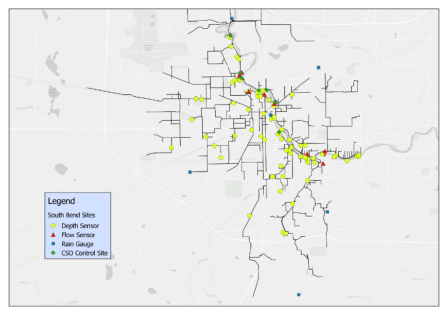Project Summary
In 2008, the City of South Bend, Indiana, working with the private company EmNet, completed the installation of a smart sewer system designed to reduce overflows of untreated sewage wastewater into the St. Joseph River.
In 2008, the City of South Bend, Indiana, working with the private company EmNet, completed the installation of a smart sewer system designed to reduce overflows of untreated sewage wastewater into the St. Joseph River.

The network of depth sensors, flow sensors and smart valves measures water levels and redirects wastewater from trunk lines approaching capacity to less stressed lines. The City used data collected from the sensors to design a more effective Long-Term Control Plan, which, according to city officials, will save an estimated $500 million dollars compared to the original Long-Term Control Plan. Additionally, data collected from the system allows City workers to monitor levels in real time and identify and remove blockages that limit sewer capacity. The system has prevented at least 1 billion gallons of raw sewage from entering the river each year since its completion. While the project was initially undertaken in order to address Clean Water Act obligations, the technology allows City engineers to divert combined sewage and stormwater to areas of the underground system that are less full, reducing the potential for street-level flooding.
| Action | Applicable Resources |
|---|---|
Conduct preliminary research, convene relevant partners, and raise necessary funds
|
|
Upgrade city facilities
|
|
Better manage infrastructure assets
|
|
In 2004, the City partnered with researchers from the University of Notre Dame and Purdue University to develop smart sensor technology to monitor and regulate water levels in the City’s combined sewer system. EmNet, the private company born from the partnership, designed, installed and maintains the system of approximately 150 sensors monitoring 111 locations across the City’s 600-mile wastewater network. The sensors collect data every five minutes, and EmNet developed algorithms that respond to the collected data and control the movement of wastewater to minimize sewer overflows.
The City of South Bend has an operations team of three people who oversee the operations of the CSO outfalls and the application of the smart sewer network on these. These full-time staff perform CSO cleaning and maintenance responsibilities, monitor the smart-sewer network and meet regularly with representatives of EmNet to evaluate the sensors.
The project is an ongoing collaboration between the City and EmNet. Overall, the system has resulted in billions of gallons of effluent pollution reduction. In 2011, the City signed a consent decree mandated by the EPA, which requires large-scale improvements to the sewer system to ensure the City is compliant with the Clean Water Act. The smart sewer system, initiated in anticipation of EPA regulations in 2004, is one piece of a larger plan to improve wastewater infrastructure that is designed to limit the number of combined sewer overflows by 2032.
Timeline
The first phase of the project, completed in 2008, included the sensor installation and data collection to design a more cost-effective Long-Term Control Plan. In 2011, the system’s controllable valves and movable weirs were installed. In 2017, the Board of Public Works approved a new three-year contract with EmNet to perform data collection and system maintenance.
Funding Source
The project cost $7 million dollars to implement and will cost an additional $280,500 per year for data collection, operations and maintenance fees. Initially, the project was a university partnership to develop smart sewer technology and funding came from the University of Notre Dame and Purdue University. EmNet, the company born from the partnership, received a $1 million grant from the Indiana 21st Century Research and Technology Fund in 2007. The company collaborated with South Bend as its pilot city for developing its wastewater control system. The infrastructure and services provided to South Bend by EmNet are currently funded with sewer utility income.
12 million hours of data were collected from the sewer sensors, which aided in the creation of a Long-Term Control Plan that will save the city approximately $500 million dollars compared to the original plan for improved wastewater management. In 2016, there were 431 million gallons of combined sewer overflows, down from over 2 billion gallons in 2008.
Lessons Learned
In February of 2018, water levels from heavy rain and snowmelt exceeded the system’s peak treatment capacity of 77 million gallons per day, leading to the release of combined sewage into the river. Increasing the capacity of the system will be a challenge as engineers anticipate more extreme precipitation events due to climate change. While the smart sewer system is meant to improve wastewater management and reduce sewer overflows, it is not specifically designed to handle extreme rain events, it nevertheless helps the City respond to and manage increased water loads in the system to reduce flooding. The large amount of data collected helps the City to understand the system at a much greater level of detail so that flow can be rerouted in order to reduce overflows that contribute to high downstream water levels.
Project managers recommend that cities seeking to adopt smart sewer technology focus on installing sensors and collecting data to help city employees better understand the capacity of their sewage system and how to best respond to future weather events. It is also important to have good communication between the smart sewer infrastructure contractor and city representatives. Having clearly defined operation procedures and designated responsibilities will help in the management and maintenance of the smart sewer system.
Project Director Kieran Fahey’s gave this advice:
“If I had to do it over again I would invest more, earlier. Taking non-traditional steps to solve age-old infrastructure problems requires a lot of brazen courage. We spent cents and saved dollars by doing this; so don’t be afraid of spending those extra cents early on. They will return the investment many times, many ways.”
Consult Global Water Intelligence’s 2017 report for more detailed information about South Bend's smart system.